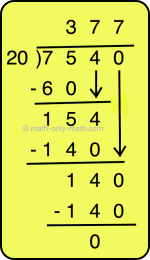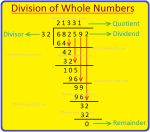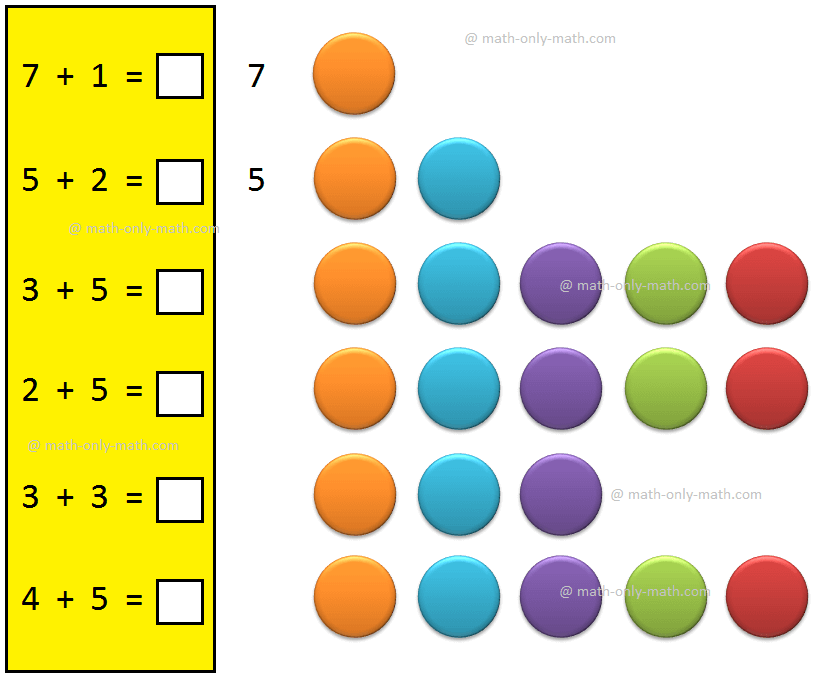Worked out Examples on Variation
In variation we will follow step-by-step some of the worked out examples on variation. Variations are classified into three types such as; direct, inverse and joint variation. Using variation, application to simple examples of time and work; time and distance; mensuration; physical laws and economics.
Step-by-step explanation on worked-out examples on variation:
1. If A varies directly as B and the value of A is 15 and B is 25, what is the equation that describes this direct variation of A and B?
As A varies directly with B,
A = KB
or, 15 = K x 25
K = \(\frac{25}{15}\)
= \(\frac{5}{3}\)
So the equation that describes the direct variation of A and B is A = B.
2. (i) If A varies inversely as B and A = 2 when B = 10, find A when B = 4.
(ii) If x ∝ y² and x = 8 when y = 4, find y when x = 32.
Solution: (i) Since A varies inversely as B
Therefore A ∝ 1/B or, A = k ∙ 1/B ………………. (1), where k = constant of variation.
Given A = 2 when B = 10.
Putting these values in (1), we get,
2 = k ∙ 1/10
or, k = 20.
Therefore, the law of variation is: A = 20 ∙ 1/B……………... (2)
When B = 4, then from (2) we get, A = 20 ∙ ¼ = 5.
Therefore, A = 5 when B = 4.
(ii) Since, x ∝ y²
Therefore, x = m ∙ y² ……………… (1)
where m = constant of variation.
Given x = 8 when y = 4.
Putting these values in (1), we get,
8 = m ∙ 42 = 16m
or, m = 8/16
or, m = 1/2
Therefore the law of variation is: x = ½ ∙ y² ………….. (2) When x = 32, then from (2) we get,
32 = 1/2 ∙ y²
or, y² = 64
or, y = ± 8.
Hence, y = 8 or, - 8 when x = 32.
3. If a car runs at a constant speed and takes 3 hrs to run a distance of 150 km, what time it will take to run 100 km?
Solution:
If T is the time taken to cover the distance and S is the distance and V is the speed of the car, the direct variation equation is S = VT where V is constant.
For the case given in the problem,
150 = V x 3
or, V = \(\frac{150}{3}\)
= 50
So speed of the car is 60 kmph and it is constant.
For 100 km distance
S = VT
or, 100 = 50 x T
T = \(\frac{100}{50}\)
= 2 hrs.
So it will take 2 hr.
4. x varies directly as the square of y and inversely as the cube root of z and x = 2, when y = 4, z = 8. What is the value of y when x = 3, and z = 27?
Solution:
By the condition of the problem, we have,
x ∝ y² ∙ 1/∛z
Therefore x = k ∙ y² ∙ 1/∛z ……(1)
where k = constant, of variation.
Given x = 2 when y = 4, z = 8.
Putting these values in (1), we get,
2 = k ∙ 4² = 1/∛8 = k ∙ 16 ∙ 1/2 = 8k
or, k = 2/8 = 1/4
Therefore the law of variation is: x = 1/4 ∙ y² ∙ 1/3√z .... (2)
When x = 3, z = 27, then from (2) we get,
3 = 1/4 ∙ y² ∙ 1/∛27 = 1/4 ∙ y² ∙ 1/3
or, y² = 36
or, y = ± 6
Therefore, the required value of y is 6 or - 6.
5. If a car runs at a speed of 60 kmph and takes 3 hrs to run a distance, what time it will take to run at a speed of 40 km?
If T is the time taken to cover the distance and S is the distance and V is the speed of the car, the indirect variation equation is S= VT where S is constant and V and T are variables.
For the case given in the problem the distance that car covers is
S = VT = 60 x 3 = 180 km.
So at a speed of the car is 40 kmph and it will take
S = VT
or, 180 = 40 x T
or, T = \(\frac{180}{40}\)
= \(\frac{9}{2}\) hrs
= 4 hrs 30 mins.
6. Fill in the gaps:
(i) If A ∝ B² then B ∝ …..
(ii) If P ∝ 1/√Q, then Q ∝ ……
(iii) If m ∝ ∛n, then n ∝ ……
Solution:
(i) Since A ∝ B²
Therefore, A = kB² [k = constant of variation]
or, B² = ( 1/k) A
or, B = ± (1/√K) √A
Therefore B ∝ √A since ± 1/√K = constant.
(ii) Since p ∝ 1/√Q
Therefore p = k ∙ 1/√Q [k = constant of variation]
Since, √Q = k/p
or, Q = k²/p²
Therefore, Q ∝ 1/p², as k² = constant.
(iii) Since, m ∝ ∛n
Therefore m = k ∙ ∛n [k = constant of variation]
or, m³ = k³ ∙ n
or, n = (1/k³) ∙ m³
Therefore n ∝ m³ as 1/k ³ = constant.
7. The area of a triangle is jointly related to the height and the base of the triangle. If the base is increased 20% and the height is decreased by 10%, what will be the percentage change of the area?
We know the area of triangle is half the product of base and height. So the joint variation equation for area of triangle is A = \(\frac{bh}{2}\) where A is the area, b is the base and h is the height.
Here \(\frac{1}{2}\) is the constant for the equation.
Base is increased by 20%, so it will be b x \(\frac{120}{100}\) = \(\frac{12b}{10}\).
Height is decreased by 10%, so it will be h x \(\frac{90}{100}\) = \(\frac{9h}{10}\).
So the new area after the changes of base and height is
\(\frac{\frac{12b}{10} \times \frac{9h}{10}}{2}\)
= (\(\frac{108}{100}\))\(\frac{bh}{2}\) = \(\frac{108}{100}\)A.
So the area of the triangle is decreased by 8%.
8. If a² ∝ bc, b² ∝ ca and c² ∝ ab, then find the relation between the three constants of variation.
Solution:
Since, a² ∝ bc
Therefore, a² = kbc …….(1) [k = constant of variation]
Again, b² ∝ ca
Therefore, b² = lca ……. (2) [l = constant of variation]
and c² ∝ ab
Therefore, c² = mab ……. (3) [m = constant of variation]
Multiplying both sides of (1), (2) and (3) we get,
a²b²c² = kbc ∙ lca ∙ mab = klm a²b²c²
or, klm = 1, which is the required relation between the three constants of variation.
Various types of worked-out examples on variation:
9. A rectangle’s length is doubled and width is halved, how much the area will increase or decrease?
Solution:
Formula for the area is A = lw where A is area, l is length and w is width.
This is joint variation equation where 1 is constant.
If length is doubled, it will become 2l.
And width is halved, so it will become \(\frac{w}{2}\).
So the new area will be P = \(\frac{2l × w}{2}\) = lw.
So the area will be same if length is doubled and width is halved.
10. If (A² + B²) ∝ (A² - B²), then show that A ∝ B.
Solution:
Since, A² + B² ∝ (A² - B²)
Therefore, A² + B² = k (A² - B²), where k = constant of variation.
or, A² - kA² = - kB² - B²
or, A² (1 - k) = - (k + 1)B²
or, A² = [(k + 1)/(k – 1)]B² = m²B² where m² = (k + 1)/(k – 1) = constant.
or, A = ± mB
Therefore A ∝ B, since ± m = constant. Proved.
11. If (x + y) ∝ (x – y), then show that,
(i) x² + y² ∝ xy
(ii) (ax + by) ∝ (px + qy), where a, b, p and q are constants.
Solution:
Since, (x + y) ∝ (x – y)
Therefore, x + y = k (x - y), where k = constant of variation.
or, x + y = kx - ky
or, y + ky = kx - x
or, y(1 + k) = (k – 1)x
or, y = [(k – 1)/( k + 1)] x = mx where m = (k - 1)/(k + 1) = constant.
(i) Now, (x² + y²)/xy = {x² + (mx)²}/(x ∙ mx) = {x² ( 1 + m²)/(x² ∙ m)} = (1 + m²)/m
or, (x² + y²) /xy = n where n = (1 + m²)/m = constant, since m = constant.
Therefore, x² + y² ∝ xy. Proved.
(ii) We have, (ax + by)/(px + qy) = (ax + b ∙ mx)/(px + q ∙ mx) = {x (a + bm)}/{x (p + qm)}
or, (ax + by)/(px + qy) = (a + bm)/(p + qm) = constant, since a, b, p, q and m are constants.
Therefore, (ax + by) ∝ (px + qy). Proved.
More worked-out examples on variation:
12. b is equal to the sum of two quantities, one of which varies directly as a and the other inversely as the square of a². If b= 49 when a = 3 or 5, find the relation between a and b.
Solution:
By the condition of the problem, we assume,
b = x + y ……... (1)
where, x ∝ a and y ∝ 1/a²
Therefore x = ka and y = m ∙ 1/a²
where k and m are constants of variation.
Putting the values of x and y in (1), we get,
B = ka + m/a² ………. (2)
Given, b = 49 when a = 3.
Hence, from (2) we get,
49 = 3k + m/9
or, 27k + m = 49 × 9 …….... (3)
Again, b = 49 when a 5.
Hence, from (2) we get,
49 = 5k + m/25
or, 125k + m = 49 × 25 …….... (4)
Subtracting (3) from (4) we get,
98k = 49 × 25 - 49 × 9 = 49 × 16
or, k = (49 × 16)/98 = 8
Putting the value of k in (3) we get,
27 × 8 + m = 49 × 9
or, m = 49 × 9 - 27 × 8 = 9 × 25 = 225.
Now, substituting the values of k and m in (2) we get,
b = 8a + 225/a²
which is the required relation between a and b.
13. If(a - b) ∝ c when b is constant and (a - c) ∝ b when c is constant, show that, (a - b - c) ∝ bc when both b and c vary.
Solution:
Since (a - b) ∝ c when b is constant
Therefore, a - b = kc [where, k = constant of variation] when b is constant
or, a - b - c = kc - c = (k - 1) c when b is constant.
Therefore a - b - c ∝ c when b is constant [since (k - 1) = constant] ….... (1)
Again, (a - c ) ∝ b when c is constant.
Therefore a - c = mb [where, m = constant of variation] when c is constant.
or, a - b - c = mb - b = (m - 1) b when c is constant.
Therefore a - b - c ∝ b when c is constant [since, (m - 1) = constant]..... (2)
From (1) and (2), using the theorem of joint variation, we get, a - b - c ∝ bc when both b and c vary. Proved.
14. If x, y, z be variable quantities such that y + z - x is constant and (x + y - z)(z + x - y) ∝ yz, prove that, x + y + z ∝ yz.
Solution:
By question, y + z - x = constant c (say)
Again, (x + y - z) (z + x - y) ∝ yz
Therefore (x + y - z) (z + x - y) = kyz, where k = constant of variation
or, {x + (y - z)} {x - (y- z)} = kyz
or, x² - (y - z) ² = kyz
or, x² - {(y + z)² - 4yz} = kyz
or, x² - (y + z)² + 4yz = kyz
or, (y + z)² - x² = (4 - k)yz
or, (y + z + x) (y + z - x) = (4 - k)yz
or, (x + y + z) ∙ c = (4 - k)yz [since, y + z - x = c]
or, x + y + z = {(4 - k)/c} yz = myz
where m = (4 - k)/c = constant, since k and c are both constants.
Therefore, x + y + z ∝ yz. Proved.
15. If (x + y + z) (y + z - x) (z + x - y) (x + y - z) ∝ y²z² then show that either y² + z² = x² or, y² + z² - x ² ∝ yz.
Solution:
Since (x + y + z) (y + z - x) (z + x - y) (x + y - z) ∝ y²z²
Therefore (y + z + x) (y + z - x) {x - (y - z)} {x + (y - z)} = ky²z²
where k = constant of variation
or, [(y + z) ² - x²] [x² - (y - z) ²] = ky²z²
or, [2yz + (y² + z² - x² )] [2yz - (y² + z² - x²)] = ky²z²
or, 4y²z² - (y² + z² - x²)² = ky²z²
or, (y² + z² - x²)² = (4 - k)y²z² = m²y²z²
where m² = 4 - k constant
or, y² + z² - x² = ± myz.
Clearly, y² + z² - x² = 0 when m = 0 i.e., when k = 4.
and, y² + z² - x² ∝ yz when m ≠ 0 i.e., when k < 4.
Therefore either, y² + z² = x²
or, y² + z² - x² ∝ yz. Proved.
● Variation
- What is Variation?
- Direct Variation
- Inverse Variation
- Joint Variation
- Theorem of Joint Variation
- Worked out Examples on Variation
- Problems on Variation
11 and 12 Grade Math
From Worked out Examples on Variation to HOME PAGE
Didn't find what you were looking for? Or want to know more information about Math Only Math. Use this Google Search to find what you need.
Recent Articles
-
Word Problems on Division | Examples on Word Problems on Division
Mar 13, 25 01:01 PM
Word problems on division for fourth grade students are solved here step by step. Consider the following examples on word problems involving division: 1. $5,876 are distributed equally among 26 men. H… -
Division of Whole Numbers |Relation between Dividend, Divisor Quotient
Mar 13, 25 12:41 PM
Relation between Dividend, Divisor, Quotient and Remainder is. Dividend = Divisor × Quotient + Remainder. To understand the relation between dividend, divisor, quotient and remainder let us follow the… -
Adding 1-Digit Number | Understand the Concept one Digit Number |Video
Mar 07, 25 03:55 PM
Understand the concept of adding 1-digit number with the help of objects as well as numbers. -
Vertical Addition | How to Add 1-Digit Number Vertically? | Problems
Mar 07, 25 02:35 PM
Now we will learn simple Vertical Addition of 1-digit number by arranging them one number under the other number. How to add 1-digit number vertically? -
13 Times Table | Read and Write Multiplication Table of 13|Times Table
Mar 07, 25 02:33 PM
In 13 times table we will learn how to read and write multiplication table of 13. We read thirteen times table as: One time thirteen is 13 Two times thirteen are 26 Three times thirteen are 39






New! Comments
Have your say about what you just read! Leave me a comment in the box below. Ask a Question or Answer a Question.